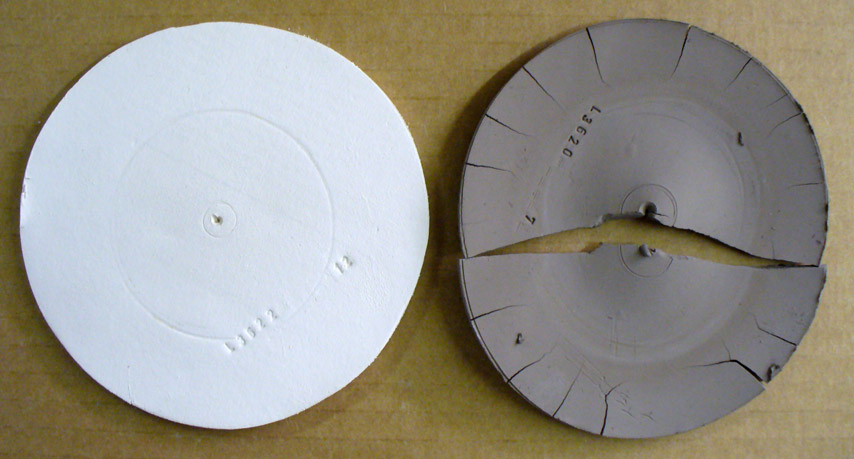| Monthly Tech-Tip | No tracking! No ads! | |
OptiKast Kaolin
Alternate Names: OptiCast
Description: Large Particle Size Kaolin
| Oxide | Analysis | Formula | Tolerance |
|---|---|---|---|
| SiO2 | 45.20% | 1.98 | |
| Al2O3 | 38.70% | 1.00 | |
| Fe2O3 | 0.50% | 0.01 | |
| TiO2 | 1.60% | 0.05 | |
| CaO | 0.10% | - | |
| K2O | 0.10% | - | |
| Na2O | 0.10% | - | |
| LOI | 13.60% | n/a | |
| C | 0.03% | n/a | |
| SO3 | 0.04% | n/a | |
| Oxide Weight | 227.46 | ||
| Formula Weight | 263.47 | ||
Notes
optiKast is a coarse-grained kaolin used primarily in ceramic casting applications. It has a very fast cast and exceptional deflocculation characteristics. Thus optiKasT is preferred in pressure casting systems.
Velvacast kaolin is no longer available, this is the recommended substitute. One concern with Velvacast was its dark fired color (compared to other common plastic kaolins). Opticast has higher iron and TiO2 contents, this will impact whiteness and certainly translucency in porcelains. We have done fired shrinkage, porosity, dry performance and plasticity comparison tests between these two materials Oct 2011 and they do appear very similar, Opticast is a little more plastic than Velvacast and does not appear to fire darker at cone 8 and 10.
Related Information
This Cone 6 Porcelain Casts Super-Fast
The type of kaolin and ball clay is the secret

This picture has its own page with more detail, click here to see it.
Rather than L4807 being just another cone 6 porcelain casting slip recipe it is a pattern of the flexibility potters/hobbyists could have in making their own bodies. We’ve never seen another body that can match how easily this deflocculates and its incredible casting speed. Don’t let anyone tell you that porcelains have to be difficult to cast.
Typical slips made from ball clay and talc (or mixes of common feldspars, clays and quartz) take 20-30 minutes to get the needed thickness (in our circumstances and assuming a new dry mold). But this one poured out in 12 minutes. We are used to extracting pieces in 30-60 minutes, with this clay I can demold in 10 minutes. The secret is not the recipe, it is similar to a typical 25-porcelain. The secret is choice of kaolin and ball clay. It employs OptiKast Kaolin and KT#1-4 ball clay, both are large particled clays targeted at slip casting.
How a kaolin and ball clay compare in a dry performance test

This picture has its own page with more detail, click here to see it.
These are DFAC drying performance disks of a large-particle kaolin (OptiKast) and a ball clay (Plainsman A2). This test reveals a clay's response to uneven drying (these disks are dried with the center portion covered). The kaolin feels smoother yet its ultimate particles are ten to one hundred times bigger than a typical ball clay. Thus it shrinks much less. The ball clay has dramatically lower water permeability, water from the center protected portion resists migration to the outer edge during drying. When the inner section finally dried the outer was already rigid so it split the disk in two and pulled all the edge cracks. Most ball clays shrink more and crack worse than this (cracks concentric to the center also appear). So why use ball clay? This kaolin is so lacking in plasticity it was barely possible to even make this disk. And it is so weak that it can easily break just by handling it. Still, it is useful to make casting bodies. But the ball clay, when used as a percentage of a body mix, can produce highly plastic bodies than can be dried without trouble if done evenly.
First Mug From v1 Prototype Mold

This picture has its own page with more detail, click here to see it.
This plaster test mold is thin-walled yet I can cast three thick-walled mugs in three hours. This clay is L2596G, a buff burning cone 10 stoneware - the mug on the lower right has been fired to cone 10 oxidation. Achieving 4-5mm thick walls is not a problem if the casting slip employs a large particle kaolin intended for this purpose (e.g. OptiKast). And it is deflocculated properly.
The flared lip works as expected, keeping the rim nice and round. No cracks have appeared at handle joins, even for pieces left in the mold overnight. The mold halves mate with each other very well and the seam is easy to remove. The seam on the base is an issue - I have to be careful to line up the halves well before clamping the mold strap - this is a warning for accuracy during the mold production stage. And the possible motive for a three-piece mold if I get more serious about this piece.
Links
| Typecodes |
Kaolin
Pure clay mineral, there are many brand names of varying purity and iron content. |
| Materials |
Velvacast Kaolin
|
Data
| % < 0.5 microns | 18.0 |
|---|---|
| % < 5 microns | 74.0 |
| % Passing 325 Mesh Wet | 94.0 |
| Modulus of Rupture - Dry | 225 psi (50/50 clay/silica) |
| Surface Area (m2/gm) | 11.0 |
| % < 20 microns | 94.0 |
| % < 10 microns | 85.0 |
| % < 2 microns | 55.0 |
| % < 1 micron | 37.0 |
| pH for dry powder | 5.7 |
| By Tony Hansen Follow me on        |  |
Got a Question?
Buy me a coffee and we can talk

https://digitalfire.com, All Rights Reserved
Privacy Policy
